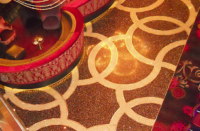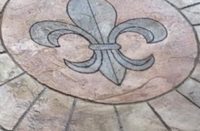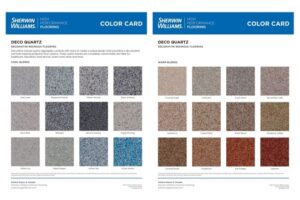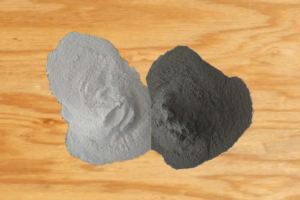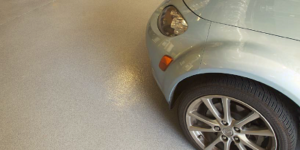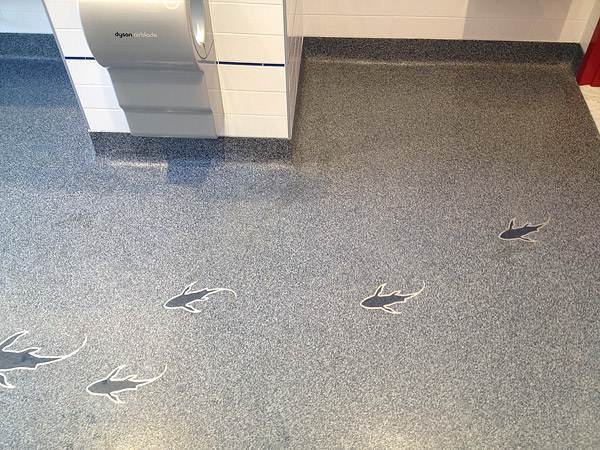
When it comes to resinous quartz flooring, the choices are broadcast vs troweled quartz. You can either broadcast the quartz onto a floor coated with wet epoxy, or you can mix the epoxy and quartz together — making what is often called epoxy mortar — then trowel it on.
Both ways will produce seamless, durable flooring that are either decorative or utilitarian. The 100 percent solids epoxy floor coating is usually clear and the quartz-sand component typically features a blend of contrasting colors with a dominant highlight color. Preblended mixtures are available from many manufacturers.
“Both systems have similar aesthetics, but inherently, the epoxy mortar system will be smoother because of its nature,” says Todd Cook, technical sales rep for Westcoat Specialty Coating Systems. “The broadcast will be more textured.”
Of the two, trowelable epoxy mortar systems tend to be more colorful. “Although a color blend may be identical (in both types of mixes), the aggregate is larger in the trowel-grade quartz, so the colors are more prominent,” says Kevin DeCarlo, president of Durex Coverings Inc., in Baltimore, Maryland, whose business involves about 85 percent resinous flooring. With a troweled installation, “You get a speckled mosaic look. With the broadcast media, you’ll get more of a monochromatic look,” he says.
Both flooring systems are good for medium to heavy-duty use, with the troweled variety the more durable option when you have wheel traffic like fork lifts, says Cook.
“A troweled system’s long-term abrasion and impact resistance are superior to a broadcast system” and subsequently cost more, DeCarlo says. As for appearance, “Broadcast can look good but troweled quartz will look slightly better. It’s sort of like better and best.”
Resinous quartz flooring
Resinous quartz flooring is designed to be used in a wide range of areas that require durable surfaces, such as research labs, manufacturing plants, bathrooms, locker rooms, kitchens, restaurants, healthcare facilities, showrooms, garages, warehouses and schools. The floors can be finished to be resistant to chemicals, stains, mildew, mold or fungus. They can be able to withstand high traffic and heavy loads, and they can be finished to offer varying degrees of skid resistance. They also can be topcoated with UV-resistant finishes so they won’t yellow in direct sunlight, and they can be colored with UV-resistant quartz sand to better maintain their hues.
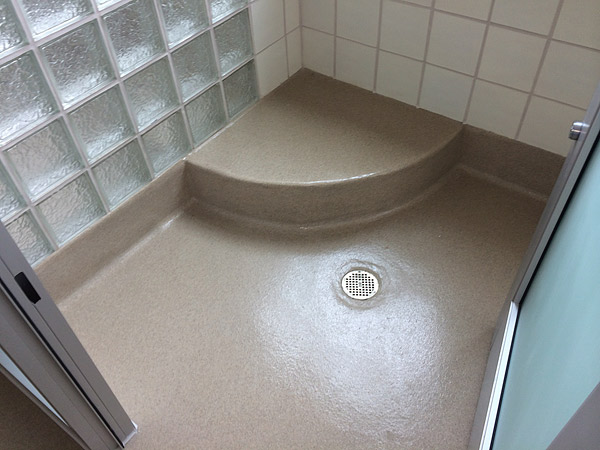
Most specialty floor coating manufacturers produce both broadcast and troweled quartz systems, with some offering one of each and others a wider selection. Key Resin Co., for instance, has several systems geared for various applications, including products that combine quartz with recycled aggregates such as crushed glass or feature rapidly renewable content in the resin.
“Using rapidly renewable or recycled content is a real trend today,” says Key president Jeff Cain. More and more contractors are interested in acquiring LEED (Leadership in Energy and Environmental Design) certification from the U.S. Green Building Council for their projects, he says. The quartz itself is not recycled.
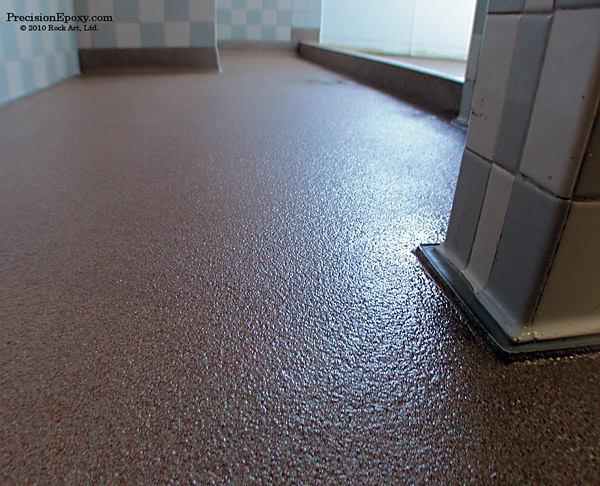
Troweled systems
According to Cain, troweled quartz systems are applied to floors prepped by bead, shotblast or grinding pad and then primed with a 100 percent solids epoxy. Next, the quartz is mixed with an epoxy binder to form the mortar, which has the consistency of semidry beach sand, and is troweled in. That topping is then grouted with a clear resin to fill in any micropores, strengthen the floor and close it off to contaminants. Finally, a topcoat is applied that ranges from an epoxy to various urethanes depending on the application desired.
Epoxy mortar installations are generally completed in less time than broadcast systems because the sand and resin are applied in one step, requiring fewer trips per job. “This reduces some of the downtimes and may result in a faster turnaround for that space,” Cook notes. “Traditionally, they are also more labor-intensive during the actual steps and might require special tooling or equipment such as gauge rakes and power trowels.”
Troweled systems are more expensive to install. You typicallyapply them at 1/4- to 3/16-inch, as opposed to a 1/8-inch-thick broadcast system. The added thickness makes them more durable. Also, emblems and more intricate designs are easier to do with troweled quartz, says Cain, and you can transfer from one color to another more seamlessly. With broadcast quartz, you’re simply tossing sand into a wet surface, he notes. “It’s harder to get crisp variation lines to form any kind of pattern.”
Installing a troweled quartz floor requires more skill, he says. “It’s more difficult to trowel a constant 1/4 inch and keep the floor flat with no trowel lines.”
“If you have a large-scale project, there’s more room for error if you have 20 hands troweling,” says Cook. “You might see an unevenness or waviness.”
Specialized power trowels
That’s where a power trowel can come in handy, says Drew Fagley. Fagley is president of HoverTrowel Inc., a company that makes lightweight power trowels originally designed and engineered for finishing colored quartz mortars. As a contractor, he says, he realized the aesthetic and physical benefits of troweled toppings as opposed to the broadcast method. However, he had concerns about the inconsistencies of troweling by hand or conventional power trowel. So his company designed its own tool.
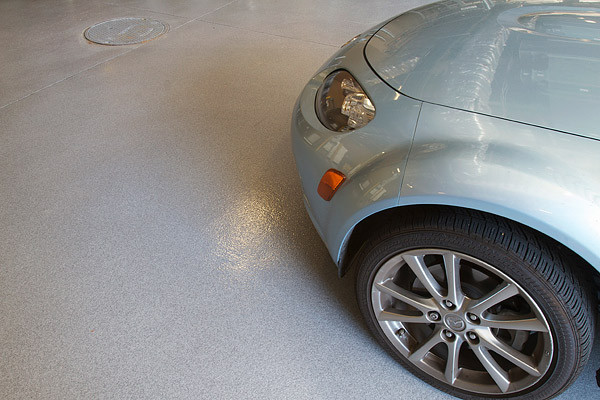
“Power-troweling with conventional power trowels or even hand-troweling can cause unsightly trowel marks,” he says. “Even experienced mechanics can have issues with troweling imperfections because of the different colored aggregates fooling the eyes. You must be careful during these installations, because grinding is not an option with the surface-coated quartz. An impeccably smooth installation is a must for the desired result.”
Power trowels designed for use with epoxy are lighter than your traditional tool, says Paulo Bergstrand. Bergstrand is president of Scanmaskin, a company that makes 110-volt and battery-run models. Most of the contractors he deals with broadcast the quartz and then trowel it in. The results from using a machine are a smoother, more compacted surface, he says. Not to mention, the installer is always standing during the installation.
Fagley notes that you can apply troweled epoxy mortars to a deteriorated or rough prepped substrate. However, you must apply broadcast systems to very smooth surfaces or the imperfections will telegraph through the broadcast.
Pros and cons of broadcast vs troweled quartz
Cook with Westcoat notes epoxy mortars can hide imperfections much better than broadcast systems and have better moisture tolerance, too. “A mortar system can be used to manipulate the contour of a substrate,” he says. “This is nice for drains or things that need a slope. You get greater control.”
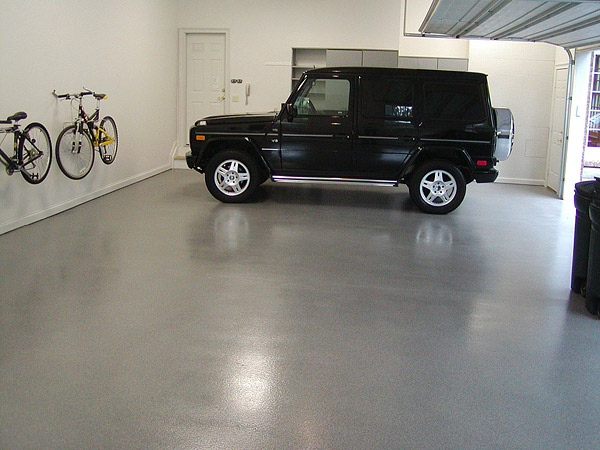
DeCarlo points out that an unforeseen benefit of troweled quartz is the resulting porosity of the blended sand and epoxy matrix. Resin-rich broadcast systems produce tighter floors but are more prone to moisture-related failures, he says.
Although DeCarlo says he prefers to hand-trowel and doesn’t often use a power trowel on decorative quartz. He says if you have skilled operators, productivity can increase greatly. But if your crew makes a mistake on a power-troweled floor, he says, it’s almost unfixable. “Unlike other systems like terrazzo or industrial mortar, if you have inconsistencies or you overtrowel a portion you can’t grind and patch your mistake.”
The broadcast-quartz system
You first must prep and prive floors with a penetrating primer coat that you intend to broadcast with quartz. Next, you apply a binder resin and toss the quartz sand by hand into the binder until the floor can’t take any more sand. After this “lift” cures overnight, one removes the excess sand with a broom and vacuum. Most applications are double-broadcast, which involves another “lift” or layer of binder and sand before the floor is sealed. The thickness of this seal coat will determine the surface finish of a broadcast. The thicker the sealer, the smoother the finish.
Comparatively, broadcast quartz systems are easier to install. Therefore, broadening the field of applicators, while achieving a look similar to troweled at a lower price. They also offer a natural built-in nonskid texture and have slightly better elongation characteristics than troweled. “It can offer a little more flex,” Cook says. “Mortar is more rigid.”
Contractors that normally lean toward the broadcast systems because of the lower price should reconsider epoxy mortar’s strengths, says Fagley. “Depending on the job size and condition of the substrate, a trowel-down topping can be cost-competitive with an honest double-broadcast” while being thicker, more durable, aesthetically more pleasing and a faster install. “It becomes an easy sell for contractors confident in their procedures and abilities.”
www.bodenkraft.com
www.durexcoverings.com
www.hovertrowel.com
www.keyresin.com
www.precisionepoxy.com
www.scanmaskin.com
www.westcoat.com

